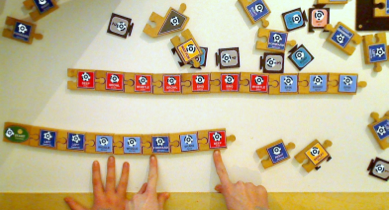RESEARCH
Much of the work done in the field of tangible interaction has focused on creating tools for learning; however, in many cases, little evidence has been provided that tangible interfaces offer educational benefits compared to more conventional interaction techniques. We conducted a study comparing the use of a tangible and a graphical interface as part of an interactive computer programming and robotics exhibit that we designed for the Boston Museum of Science. We have collected observations of 260 museum visitors and conducted interviews with 13 family groups. Our results show that visitors found the tangible and the graphical systems equally easy to understand. However, with the tangible interface, visitors were significantly more likely to try the exhibit and significantly more likely to actively participate in groups. In turn, we show that regardless of the condition, involving multiple active participants leads to significantly longer interaction times. Finally, we examine the role of children and adults in each condition and present evidence that children are more actively involved in the tangible condition, an effect that seems to be especially strong for girls.
Graphical and Tangible Programming
This study provides concrete evidence that tangible interaction can be an effective way to promote intrinsically motivated educational activities for children.
Related Publication:
M.S. Horn, E.T. Solovey, R.J. Crouser, and R.J.K. Jacob, “Comparing the Use of Tangible and Graphical Programming Languages for Informal Science Education,” Proc. ACM CHI 2009 Human Factors in Computing Systems Conference, ACM Press (2009). [Acceptance Rate: 24.5%] [link]
